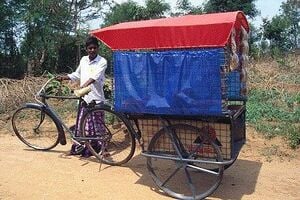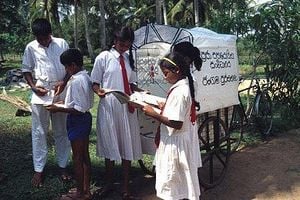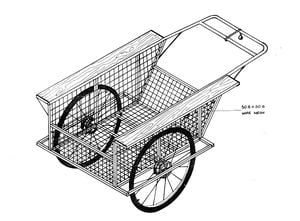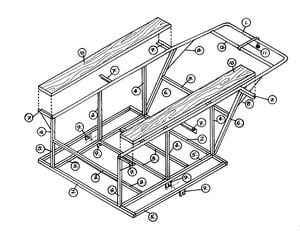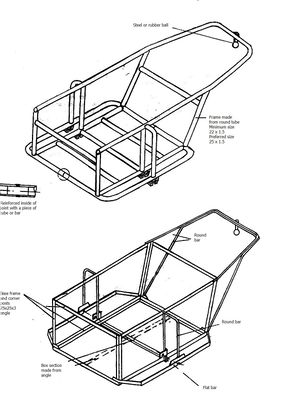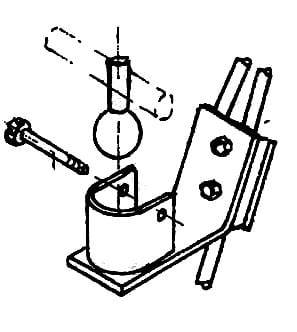In many developing countries people live in regions away from the main transport infrastructure. This means transport services are expensive Many villages in the South are not part of road networks and the lack of transport is a constraint on income generating activities such as taking produce to markets and acquiring equipment and materials needed for a small enterprise.
The approach of Practical Action is to promote a view of transport systems that addresses problems of access and mobility for rural people
Strengthen capacity of communities to control & manage transport facilities
Practical Action has worked on a range of transport technologies that address different transport needs, such as Ox carts, extended load carrying bicycles, aerial runways, bicycle taxis, bicycle ambulances, wheelbarrows, low cost wheelmaking, animal harnesses, low cost road construction and bicycle trailers. Cycle trailers are used for transporting goods, fuel, water and harvests where other means are too expensive
Trailers allow people can now carry three times as much as with a bicycle, which allows people to carry around 200 kilograms (450 lbs.)
The range of use is quite wide including ambulances, mobile shops, and even a mobile library in one instance in Sri Lanka, shown in figure 2.
Bicycle trailers[edit | edit source]
Bicycle trailers were developed within Practical Action South Asia (Sri Lanka) then adopted by Practical Action East Africa (Kenya) and now in Nepal and Zimbabwe.
To make sure that the cycle trailer are affordable, Practical Action works with local partner organizations who operate credit schemes at low interest rates.
How to make a bicycle trailer[edit | edit source]
The cycle trailers are made in small village workshops from iron tubing, which is cut, bent, welded and drilled to make the frame and wheels. Modifications are also carried out to the trailers in these workshops at the request of the buyers.
Figure 3 shows one of the designs produced by Practical Action
The frame needs to be strong and rigid but as light as possible. Thin wall tube gives the best design but is not always available or affordable and some skill is needed to weld the thin material.
Details of the Frame Construction[edit | edit source]
The component parts to the frame design are listed in table 1
| Part | Description | Qty | Material | Semi Finished Dimensions |
|---|---|---|---|---|
| 1 | Round Tube | 1 | Mild Steel | 19.05 x 2713 |
| 2 | Square Tube | 2 | Mild Steel | 19.05 x 914 |
| 3 | Square Tube | 5 | Mild Steel | 19.05 x 623 |
| 4 | Square Tube | 6 | Mild Steel | 19.05 x 382 |
| 5 | Square Tube | 4 | Mild Steel | 19.05 x 877 |
| 6 | Square Tube | 2 | Mild Steel | 19.05 x 445 |
| 7 | 'L' Angle | 6 | Mild Steel | 19.05 x 19.05 x 125 |
| 8 | Rod | 2 | Mild Steel | 09 x 240 |
| 9 | Wheel Mounting | 4 | Mild Steel | 50.8 x 50.8 x 6.35 |
| 10 | Plank | 2 | Wood | 873 x 126 x 15 |
| 11 | Hitch (Male) | 1 | Mild Steel | |
| 12 | Round Tube | 1 | Mild Steel | 19.05 x 560 |
Table 1: Parts list for the bicycle trailer frame.
Hitch[edit | edit source]
Although hitching the trailer at the level of the rear axle has the least effect on the stability of the bicycle, hitching above the rear wheel. (to the carrier or to the frame below the seat) is simpler and more compatible with duel use of the trailer as a handcart. This method has been widely tested on earth roads and tracks in various countries and has caused no problems for the trailer users. Various hitch mechanisms may be used, the requirement being that they are strong and durable and do not constrain relative movement between the bicycle and the trailer. The recommended mechanism is a rubber ball in a steel socket attached to the carrier or the rear wheel stays, but in some cases, the trailer has simply been tied to the carrier.
Wheels[edit | edit source]
Normal bicycle wheels are suitable for light loads on good roads but are not robust enough for carrying heavy loads or for use on rough tracks. Strengthened wheels that take standard bicycle tyres have been developed for trailers.
References and further reading[edit | edit source]
- The Design of Bicycle Trailers Michael Ayre IT Publications 1986
- Low-cost Load-carrying Devices: The Design & Manufacture of Some Basic Means of Transport Ron Dennis and Alan Smith ITDG Publishing 1995
- Puncture Prevention Techniques for Low Cost Vehicles Michael Ayre & Alan Smith
- Cycle Trailers for India. Appropriate Technology Vol. 18 No 2
- Forum News. The International Forum for Rural Transport and Development
A quarterly newsletter looking at the issues of transport with animal power, bridges, bicycles, gender and transport, financing, engineering, sustainable rural livelihoods, community planning. IFRTD's address is shown below.
Useful contacts[edit | edit source]
I. T. Transport is a consultancy in transport for rural development.
I.T. Transport Ltd.
The Old Power Station
Ardington, Nr. Wantage
Oxon
OX12 8QJ
United Kingdom
Tel: +44 1235 833753 /821366
Fax: +44 1235 833753/821366
E-mail: itt@ittransport.co.uk
Website: https://ittransport.co.uk/
The International Forum for Rural Transport and Development is a global network of individuals and representatives from government, academia, multilateral and bilateral donor agencies, consultancies and technical institutions, national and international NGOs and groups of community organizations in 83 countries in Africa, Asia, Europe and North and South America.
IFRTD Secretariat
2 Spitfire Studios
63-71 Collier Street
London, N1 9BE
United Kingdom
Tel: 44 20 7713-6699
Fax: 44 20 7713-8290
E-mail: ifrtd@gn.apc.org
Website: http://ifrtd.gn.apc.org/
Internet addresses[edit | edit source]
World Bank http://www.worldbank.org/html/fpd/transport/rural_tr/rts_imt.htm#patterns
The DFID transport site is managed by TRL (Transport Research Laboratory). www.transport-links.org
